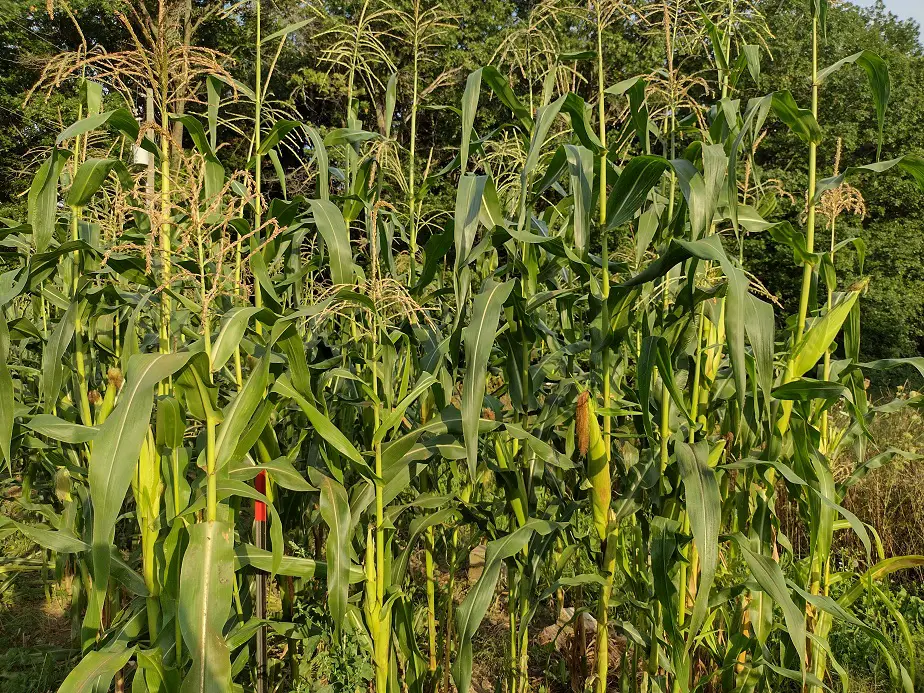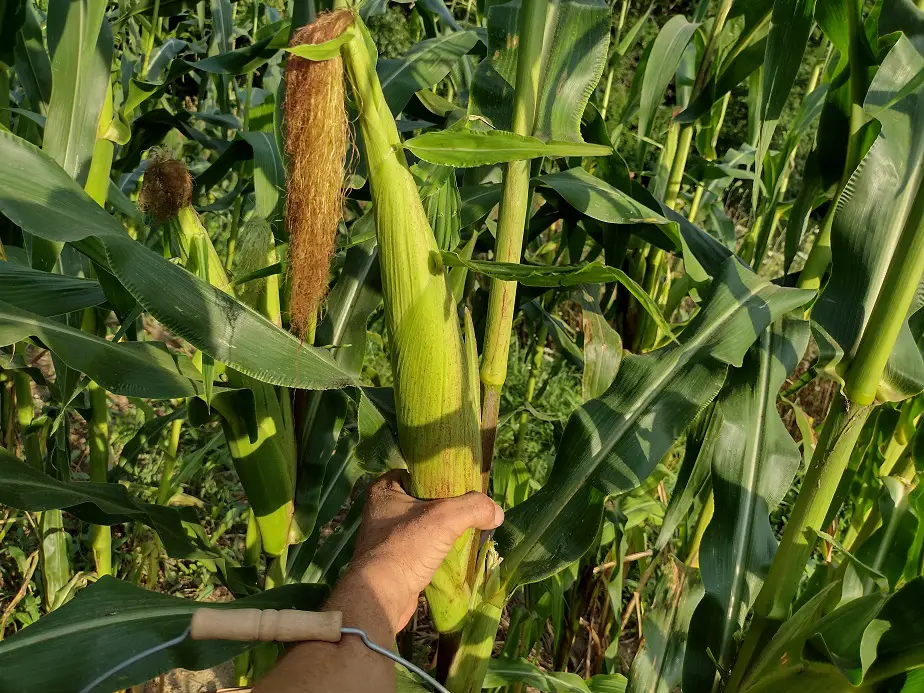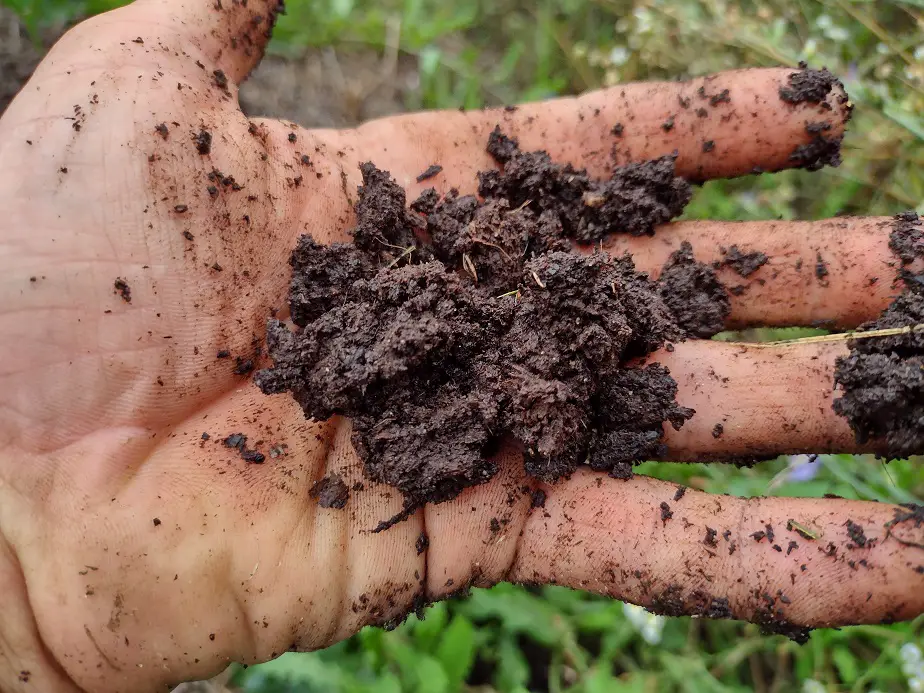Before you can settle on a product, you need to understand what they are, how they work, and what your soil needs. That said, here are the products I’d be likely to recommend and what I’d use for fertilizing sweet corn.
Hybrix Sweet Corn Fertilizer
Hybrix Sweet Corn fertilizer is probably the best single fertilizer blend you can buy for sweet corn. It’s got a great macronutrient level, and it has the addition of the most commonly lacking micronutrients. it has an N-P-K (nitrogen, phosphorus, and potassium content) of 16-7-10. That’s a pretty decent blend.
Although I usually prefer to make my blends a bit lower in N, or higher in the P and K depending on how you look at it, it’s still pretty darn good. Generally, you’re going to the NPK ratio to be around 4-2-3, or something near that. I’ve also heard it as 100-50-80. That’s just a ratio.
So, however much nitrogen you need, then about 50 percent as much potassium and 80 percent as much phosphorus by mineral weight. The Hybrix also has calcium (Ca2) and Sulfur added. Most sold are not lacking in either, but some are quite a bit. In sandy, saline, or volcanic soil, it’s usually a good idea.
It’s also a good idea for a field or garden that’s been heavily used and well-worked for a long time. In that instance, even soils that should have been good have lost a lot of these minerals and are often lacking. Boron is the most common lacking micronutrient, and very few fertilizers have any. This one does.
It also has Calcium and Sulfur, which are lacking in some soils.
Hybrix Sweet Corn Fertilizer is designed to fix all common soil problems and make the perfect fertility for sweet corn.
It even helps increase the cation exchange rate in the soil by adding some positively charged Ca2 and S6. According to the manufacturer, You can use this fertilizer at much lower rates than most, because of that action. It’s expensive, but they say you can use it at half the rate of regular fertilizer recommendations.
Miracle-Gro
Miracle-Gro is actually a very good fertilizer blend for sweet corn. I’m talking about the original one with an NPK of 24-8-16. It has a very good nutrient level and contains all the micronutrients corn needs. It’s not so strong that it will easily burn everything, but it’s still fairly potent.
I could certainly fertilize my entire corn fields with the stuff. It’s not a bad product in and of itself. Now, the only thing I don’t care for is the parent company. Miracle-Gro is owned by Scotts, which is owned by Monsanto. In my opinion, Monsanto is a genetics and chemical company without a conscience.
While it’s a good product, I’ll use my free-market rights and buy from a different manufacturer. It can be used at about 2 pounds per 100 square feet of corn.
Sweet Corn Alive from Garden Alive
This is one I haven’t used, but I know people who have. It seems to be a fine product. It’s blended with an NPK of 6-3-3. I’ll take that. It’s a nitrogen-high fertilizer mix, which is a big plus for corn. It’s not the cheapest but good for small plots. People say it’s leaps and bounds over a basic 10-10-10 type fertilizer.
This fertilizer is on the low-potency end. That’s good in a way because it’s harder to overdo it. Over-application of fertilizer is a very harmful action on soil microbiology and severely impacts the healthfulness and nutrition of your crop. For larger areas, I would go with a different option though.
I would use about 6 pounds per 100 square feet of corn.

Chicken manure pellets
Chicken manure pellets are a pretty interesting natural fertilizer. It’s a low-strength product and usually has an NPK of around 3-1-1 or 4-2-2. It can be used as a complete fertilizer for sweet corn and due to the micronutrients and organic compounds, it can cause an increased brix level in your sweet corn.
That means it’ll be sweeter and more flavorful. It also meant it will better resist fungus and disease. It’s also worth noting that a higher-Brix plant tends to have significantly less pest damage than low-Brix plants. I’ve seen people treat corn for cornworm by sharply increasing the Brix levels.
Most, but not all of these pelleted manures are certified organic fertilizers. I haven’t bought a pelleted product, but I use manures as the primary fertilizer for our operation. Since most manures are quite low in nitrogen, we rely on chicken manure for the nitrogen. It’s as strong as the pelleted product.
The problem with this product is just how much you need. There’s only about 1-1/2 pounds of nitrogen in a 50-pound bag so you have to put it on thick. You can use it at about 16 or 17 pounds per 100 square feet of corn.
10-10-10
10-10-10- is the most common fertilizer used for sweet corn but it’s not the best. Using this can cause phosphorus build-up in the soil which limits the availability of other nutrients. It certainly can do the job, but you should do a soil test first to see if you already have a lot of phosphorus in the soil.
In order to get enough nitrogen with any even-numbered NPK fertilizer, you’re going to have twice the phosphorus needed. Phosphorus doesn’t leach much from the soil like other nutrients, so it stays there pretty well if not used by plants. If you continually use this fertilizer year after year, you can get a condition known as phosphorus toxicity.
That’s when the phosphorus level in the soil gets overly high, it begins to attract most of the other nutrients to it and lock them up in a big molecule chain that plants aren’t able to break. If this happens, you have some rough problems and can’t grow a good crop of something like corn.
You can use it at about 4-1/2 pounds per 100 square feet.
Trifecta+ from MIgardener
Trifecta+ from MIgardener is a high-quality fertilizer blend made from outstanding all-natural ingredients. It is a general-use garden blend, but will need nitrogen supplementation for sweet corn. It’s designed with a combination of slow-release and fast-release macronutrients. It’s NPK if 5-10-14.
It also has the benefit of over 70 micronutrients. Only about 8 of those micronutrients directly benefit plants. the rest are there to support a healthy soil web of beneficial bacteria, nematodes, amoebas, and fungi. It also contains beneficial bacteria and fungus, but they don’t say which Ones.
This mix will work in any soil, but will really help reclaim old, well-worn or heavily disturbed soil. It will also build up soil lacking in organic matter. For sweet corn, I would use this as a base, and add some nitrogen to it; probably bone meal or urea. Bone meal is organic but expensive. Urea is cheap but harsh, use it with care.
Because a lot of the phosphorus in it comes from rock phosphate, which has a very slow breakdown and release period, it’s not as bad as a 10-10-10. I would use it at around 8 to 9 pounds per 100 square feet of growing space.

How Much Fertilizer for Sweet Corn?
Sweet Corn is generally fertilized at a rate of 150-200 pounds of nitrogen per acre. Phosphorus and potassium and generally applied at around 100 and 150 pounds per acre. Calcium, magnesium, and boron are sometimes needed based on a soil mineral test.
For smaller areas, You can calculate how much is needed relatively easily. If you want to fertilize 100 square feet, divide the total fertility you want by 430 and divide it by the strength of your fertilizer. Then just weigh out that many pounds of fertilizer.
So, if I wanted 200 pounds N per acre (a heavy but not extra-heavy amount), I’d do 200 pounds N divided by 430= 0.46 pounds N. If I was using a 10-10-10 (10 percent each N, P, K), I’d do 0.46 pounds divided by 0.1 ( that’s 10 percent). The answer is 4.6 pounds of 10-10-10 to fertilize 100 square feet at the rate of 200 pounds N per acre.
If you have additional questions on amounts, leave a comment at the bottom of the page.
In very sandy soil, you may have to use nearly twice as much fertilizer because it washes out. That’s why with sandy soil, it’s extra important to amend it with compost, manure, or biochar to prevent nutrient leaching. In heavy clay soil, you may be able to use 25 percent, or more, less fertilizer than traditional estimates.
In clay soil nutrients are better held in the soil and water does not leach minerals out to any great extent. Still, in clay soil using a nice manure or biochar product can greatly improve soil structure and beneficial microbiological activity. I will be packaging and selling my premium, inoculated biochar in the near future.
I personally would fertilize at an NPK rate of 175 pounds N, 100 pounds P, and 140 pounds K per acre. That’s usually going to be pretty good for my soil, considering our current soil and fertility management practices and what I expect our soil nutrient levels to be before planting season.

Soil Amendments for Sweet Corn
The best soil amendments for sweet corn are manure, quality compost, and premium inoculated biochar. In acidic and neutral soils, Biochar and manure are the better choices most of the time. In alkaline soils, compost is usually the better option.
I’ve been manufacturing and tweaking my own custom biochar blend inoculated with organic fertilizer and active Lactobacillus microbes. lactobacillus, or LABs, are also known as lactic acid bacteria. They are perhaps the most understood fraction of soil microlife.
Labs are naturally found in manures and in some fermented products. They boost soil structure and absorption, reduce fertility leaching, break down tough organic matter, and help control bad bacteria in the soil. I’m literally working with several colonies of LABs right now.
Here is a simple article about LAB’s benefits to soil.
Here’s a more technical and complicated version.
Compost will help almost any soil you’ve ever seen. It’s exceedingly rare for a soil to be harmed by compost. I know a few people who garden in raised beds filled with pure compost. It can end up holding too much water and getting boggy if you use a lot, in some instances.
Manure is basically half-composted plant material. It’s got some nutrition that’s ready for plants, and more that’s going to break down over the coming years. It will improve the soil and can be applied heavily in the fall or early spring.
Related Articles:


